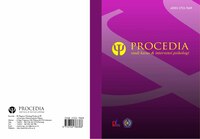Meningkatkan kemandirian toilet training anak dengan Global Developmental Delay
DOI:
https://doi.org/10.22219/procedia.v11i2.23787Keywords:
Global developmental delay, positive reinforcement, toilet trainingAbstract
Each level of age in humans will have certain developments. Likewise, at the age level of children, there will be abilities that will increase as they get older. Children aged 4-5 years have started to have the ability to apply self-help skills to meet their basic needs such as food, clothing, grooming, personal hygiene and independence in going to the toilet. The client is the youngest daughter of 2 siblings. Children with global developmental delay problems will have difficulties in self-care. He is 4 years old. The client lives with his parents, brother and grandmother. Until now the client has not been able to behave independently of his daily activities such as going to the toilet himself. The purpose of this case study is to improve the subject's ability to be independent with toilet training. The assessments used were observation, interviews and VSMS (Vineland Social Maturity Scale). The intervention given to improve the toilet training ability of the client was the provision of positive reinforcement. The results of the intervention that had been given to the client showed significant changes, namely a decrease in the intensity of bed wetting and an increase in the ability to take off/put on pants, wash, flush and wash hands independently. However, clients still need family assistance in going to the toilet or must remain with parental assistance and initiative.
Setiap tingkatan usia pada manusia akan memiliki perkembangan tertentu. Demikian pula pada tingkat usia anak-anak, akan ada kemampuan yang akan meningkat seiring bertambahnya usia. Anak usia 4-5 tahun sudah mulai memiliki kemampuan untuk menerapkan keterampilan menolong diri sendiri untuk memenuhi kebutuhan dasarnya seperti makanan, pakaian, dandan, kebersihan diri dan kemandirian ke toilet. Klien adalah putri bungsu dari 2 bersaudara. Anak dengan masalah keterlambatan perkembangan global akan mengalami kesulitan dalam perawatan diri. Klien berusia 4 tahun tinggal bersama orang tua, kakak dan neneknya. Sampai saat ini klien belum dapat berperilaku mandiri dalam aktivitas kesehariannya seperti ke toilet sendiri. Tujuan dari studi kasus ini adalah untuk meningkatkan kemampuan klien untuk mandiri dengan toilet training. Penilaian yang digunakan adalah observasi, wawancara dan VSMS (Vineland Social Maturity Scale). Intervensi yang diberikan untuk meningkatkan kemampuan toilet training klien adalah pemberian penguatan positif. Hasil intervensi yang telah diberikan pada klien menunjukkan perubahan yang signifikan yaitu penurunan intensitas mengompol dan peningkatan kemampuan melepas/memakai celana, mencuci, menyiram dan mencuci tangan secara mandiri. Namun, klien tetap membutuhkan pendampingan keluarga dalam ke toilet atau harus tetap dengan pendampingan dan inisiatif orang tua.
Downloads
References
American Psychiatric Association. (2013). Diagnostic and statistical manual of mental disorders: DSM-5 (Vol. 5, No. 5). Washington, DC: American psychiatric association.
Bhutto, Z. H., & Siddiqui, S. (2013). Application of Positive Reinforcement for Improving Mealtime Eating of a Child in Home Setting: A Case Study. Journal of Behavioural Sciences, 23(1).
Boutain, A. R., Sheldon, J. B., & Sherman, J. A. (2020). Evaluation of a telehealth parent training program in teaching self‐care skills to children with autism. Journal of Applied Behavior Analysis, 53(3), 1259-1275. url{https://doi.org/10.1002/jaba.743
Cocchiola, Michael., Martino, Gayle., Dwyer, Lisa., and Demezzo, Kelly. (2012). Toilet Training Children with Autism and Developmental Delays: An Effective Program for School Settings. Journal of Behavior Analysis in Practice, 5(2), 60-64
Corey, Gerald. (2013). Teori dan Praktek Konseling & Psikoterapi: Terjemah E. Koswara. Bandung. Refika Aditama
Crnic, K. A., Neece, C. L., McIntyre, L. L., Blacher, J., & Baker, B. L. (2017). Intellectual disability and developmental risk: Promoting intervention to improve child and family well‐being. Child development, 88(2), 436-445. url{https://doi.org/10.1080/03004430.2014.908866
Dwi Utami, A., & Yunitami, R. (2014). Pengembangan ketrampilan membantu diri sendiri pada anak panti asuhan usia 4-5 tahun. In Jurnal Ilmiah VISI P2TK PAUDNI, 9, (2).
Halford, G. S. (2014). Children's understanding: The development of mental models. Psychology Press.
Jimenez-Gomez, A., & Standridge, S. M. (2014). A refined approach to evaluating global developmental delay for the international medical community. Pediatric neurology, 51(2), 198-206. url{https://doi.org/10.1016/j.pediatrneurol.2013.12.018
Miclea, D., Peca, L., Cuzmici, Z., & Pop, I. V. (2015). Genetic testing in patients with global developmental delay/intellectual disabilities. A review. Clujul Medical, 88(3), 288. url{https:// doi:10.15386/cjmed-461
Le, T., & Baik, S. W. (2019). A robust framework for self-care problem identification for children with disability. Symmetry, 11(1), 89. url{https://doi.org/10.3390/sym11010089
Lin, C. L., Lin, C. K., & Yu, J. J. (2018). The effectiveness of parent participation in occupational therapy for children with developmental delay. Neuropsychiatric disease and treatment, 623-630. url{https:// /doi/full/10.2147/NDT.S158688
Setiawati, D. N. A. E. (2020). Teknik penguatan positif untuk anak dengan keterbatasan intelektual. Procedia: Studi Kasus Dan Intervensi Psikologi, 7(1). url{https://doi.org/10.22219/procedia.v7i1.12976
Shevell, M. I. (1998). The Evaluation of the Child With a Global Developmental Delay. Seminars in Pediatric Neurology, 5(1), 21–26. url{https://doi.org/10.1016/s1071-9091(98)80014-4
Zaini, Munthe & Aryani. (2008). Strategi Pembelajaran Aktif. Yogyakarta: CTSD
Downloads
Published
How to Cite
Issue
Section
License
Copyright (c) 2023 Najwa Wafiyyah

This work is licensed under a Creative Commons Attribution-NonCommercial 4.0 International License.






